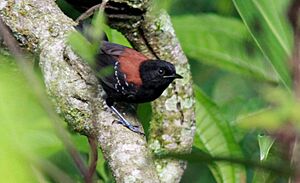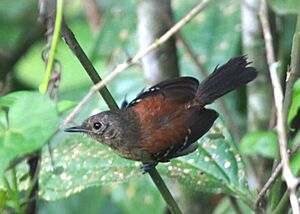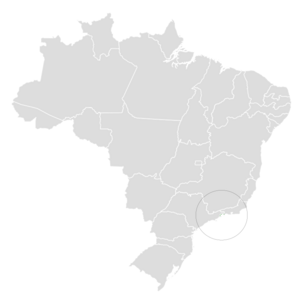Black-hooded antwren facts for kids
Quick facts for kids Black-hooded antwren |
|
|---|---|
 |
|
| Male | |
 |
|
| Female | |
| Conservation status | |
| Scientific classification | |
| Genus: |
Formicivora
|
| Species: |
erythronotos
|
 |
|
| Synonyms | |
|
Myrmotherula erythronotos |
|
The black-hooded antwren (Formicivora erythronotos) is a small bird. It is an Endangered Species, which means it is at risk of disappearing forever. This special bird lives only in Brazil. It belongs to a group of birds called "typical antbirds".
Contents
What's in a Name?
Scientists give every animal a special name. The black-hooded antwren was first named Formicivora erythronotos. For many years, it was placed in a different group called Myrmotherula. But around the year 2000, scientists studied the bird's body and sounds. They decided it should go back into the Formicivora group. This bird is also monotypic. This means it is the only species in its group.
What Does It Look Like?
The black-hooded antwren is about 11 cm (4.3 in) long. That's about the length of a pen!
Male Birds
Adult males have a deep reddish-brown color on their back. Their rump and upper tail feathers are also this color. Most of the rest of their body is black. They have white tips on their wing feathers. Their sides are white. The middle of their throat and chest are black. Their lower tail feathers have white stripes.
Female Birds
Adult females also have reddish-brown upper parts. The rest of their body is mostly olive-brown. This color is lighter on their belly. Their wings and tail are blackish. They also have white tips on their wing feathers. Females might have thin dark lines or spots on their head and throat. Both male and female birds have a thin black beak.
Where Does It Live?
The black-hooded antwren was first known from birds collected in the 1800s. But then, it wasn't seen for over 100 years! It was rediscovered in 1987.
People once thought it lived further inland. But now we know it lives along the coast of Baía da Ilha Grande. This area is in the Rio de Janeiro state of Brazil. It likes to live in places where new forests are growing. This includes young second-growth forests. It also lives in old banana farms that are turning back into forests.
How Does It Behave?
Staying in One Place
Scientists believe the black-hooded antwren stays in the same area all year. It does not migrate to other places.
What It Eats
We don't know everything about what the black-hooded antwren eats. But we do know it eats insects and spiders. It also eats small frogs. This bird usually looks for food alone or in pairs. Sometimes, a family group will forage together. It rarely joins other bird species to find food.
It usually looks for food close to the ground. It often forages between the ground and about 3 m (10 ft) high. Sometimes, it will go as high as 7 m (23 ft). It actively searches for food. It picks most of its prey from leaves, vines, branches, and stems. Sometimes, it flies a short distance from a branch to grab food from under a leaf. It does not follow swarms of army ants.
Building a Home
Black-hooded antwren nests have been found from mid-August to February. Both the male and female birds help build the nest. The nest is a small cup shape. It is made from small roots and plant fibers. Green moss-like plants are often on the outside. The nest is attached to a small branch near the ground.
Usually, two eggs are laid. The eggs hatch after 13 to 15 days. The baby birds leave the nest 10 to 11 days after hatching. Both parents help care for the eggs and the young birds. The female bird usually stays on the nest at night.
What It Sounds Like
The black-hooded antwren's song is a high, rattling sound. It sounds like "tjotjotjo---" and lasts for 2 to 3 seconds. Some people describe it as a series of low-pitched "tchóup" calls. Its other calls include a soft "chep-ep". It also makes a loud, nasal sound that goes down in pitch. This sound is often heard twice.
Why Is It Endangered?
The IUCN is a group that checks on endangered animals. They first said the black-hooded antwren was "Threatened" in 1988. Then, in 1994, they called it "Critically Endangered". Since 2000, it has been listed as "Endangered".
This bird lives in a very small area. Its habitat is also broken up into many small pieces. About 90% of these birds live in just two of these small areas. Scientists believe there are between 300 and 8500 adult birds left.
People are building many homes and hotels along the coast. This development is taking away the small patches of forest where the bird lives. Brazilian authorities also list it as Critically Endangered. The United States also added it to its Endangered Species List in 2010.


